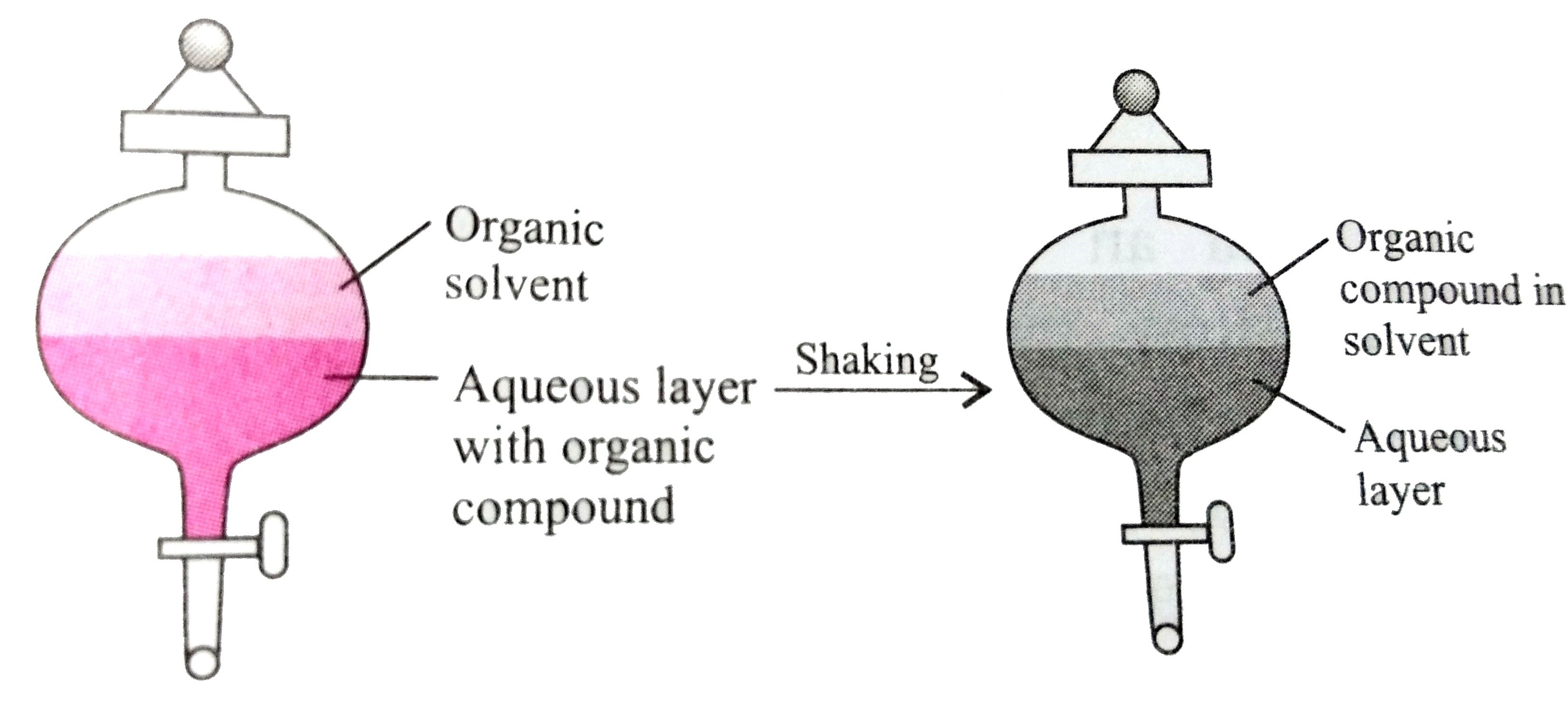Why does only the organic layer assure colour and not the aqueous layer when the tests for halides are done?
Step-by-Step Solution:
1. Understanding Halides:
- Halides are anions such as chloride (Cl⁻), bromide (Br⁻), and iodide (I⁻). When testing for halides, we are typically looking to identify these ions.
2. Oxidation to Diatomic Compounds:
- In qualitative analysis, halides are oxidized to their diatomic forms:
- Chloride (Cl⁻) is oxidized to chlorine (Cl₂),
- Bromide (Br⁻) is oxidized to bromine (Br₂),
- Iodide (I⁻) is oxidized to iodine (I₂).
- These diatomic forms are colored:
- Chlorine is yellow-green,
- Bromine is reddish-brown,
- Iodine is violet.
3. Solubility of Diatomic Compounds:
- The diatomic halogens (Cl₂, Br₂, I₂) are covalent compounds.
- According to the principle of "like dissolves like," covalent compounds are more soluble in organic solvents than in water (aqueous layer).
4. Organic Layer vs. Aqueous Layer:
- The organic layer, being non-polar or less polar, is more suitable for dissolving covalent compounds.
- Therefore, when halides are tested, the color produced by the diatomic halogens is observed in the organic layer rather than in the aqueous layer.
5. Conclusion:
- The organic layer assures color because the diatomic halogens, which are responsible for the color, preferentially dissolve in the organic solvent due to their covalent nature. The aqueous layer does not show color because it cannot effectively dissolve these covalent compounds.
- Halides are anions such as chloride (Cl⁻), bromide (Br⁻), and iodide (I⁻). When testing for halides, we are typically looking to identify these ions.
- In qualitative analysis, halides are oxidized to their diatomic forms:
- Chloride (Cl⁻) is oxidized to chlorine (Cl₂),
- Bromide (Br⁻) is oxidized to bromine (Br₂),
- Iodide (I⁻) is oxidized to iodine (I₂).
- These diatomic forms are colored:
- Chlorine is yellow-green,
- Bromine is reddish-brown,
- Iodine is violet.
- The diatomic halogens (Cl₂, Br₂, I₂) are covalent compounds.
- According to the principle of "like dissolves like," covalent compounds are more soluble in organic solvents than in water (aqueous layer).
- The organic layer, being non-polar or less polar, is more suitable for dissolving covalent compounds.
- Therefore, when halides are tested, the color produced by the diatomic halogens is observed in the organic layer rather than in the aqueous layer.
- The organic layer assures color because the diatomic halogens, which are responsible for the color, preferentially dissolve in the organic solvent due to their covalent nature. The aqueous layer does not show color because it cannot effectively dissolve these covalent compounds.
Topper's Solved these Questions
- QUALITATIVE INORGANIC SALT ANALYSISBOOK - CENGAGE CHEMISTRY ENGLISHCHAPTER - QUALITATIVE INORGANIC SALT ANALYSISEXERCISE - Viva Voce Questions And Part-B (Dry Tests)
9 Videos
- QUALITATIVE INORGANIC SALT ANALYSISBOOK - CENGAGE CHEMISTRY ENGLISHCHAPTER - QUALITATIVE INORGANIC SALT ANALYSISEXERCISE - Viva Voce Questions And Part-C (Analysis Of Cations)
42 Videos
- QUALITATIVE INORGANIC SALT ANALYSISBOOK - CENGAGE CHEMISTRY ENGLISHCHAPTER - QUALITATIVE INORGANIC SALT ANALYSISEXERCISE - Ex 8.2
78 Videos
- P-BLOCK GROUP 18 ELEMENTS - THE INERT GASESBOOK - CENGAGE CHEMISTRY ENGLISHCHAPTER - P-BLOCK GROUP 18 ELEMENTS - THE INERT GASESEXERCISE - Ex 5.1 (Objective)
14 Videos
- REDUCTION AND OXIDATION REACTION OF ORGANIC COMPOUNDSBOOK - CENGAGE CHEMISTRY ENGLISHCHAPTER - REDUCTION AND OXIDATION REACTION OF ORGANIC COMPOUNDSEXERCISE - SUBJECTIVE TYPE
4 Videos
Similar Questions
CS2 layer gives a test for
View SolutionWhy does phenolphthalein assume pink colour in alkaline solutions?
View SolutionThe process of separation of an organic compound from its aqueous solution by shaking with a suitable solvent in termed solvent extraction or differential extraction.

The organic compound present in the aqueous layer moves to the organic solvent because
View SolutionWhy does dry HCl gas not change the colour of the dry litmus paper?
View SolutionWhy is damage to the ozone layer a cause for concern? What steps are being taken to limit this damage?
View SolutionWhich of the following organelles does not have a double layer ?
View SolutionAssertion: Testes are retroperitoneal organ in man.
Reason: Peritoneal layer covers the testes on the dorsal side.
View SolutionLayer test is used to detect the presence of
View SolutionHydrazine does not give Lassaigne's test for nitrogen. Why ?
View SolutionWhy does the bluish colour predominate in a clear sky?
View Solution
